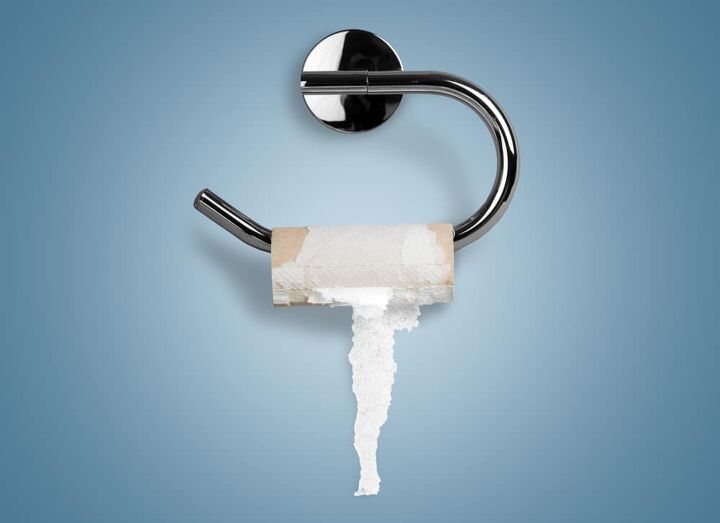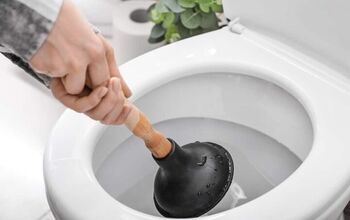How To Dissolve A Toilet Paper Clog (Quickly & Easily!)

Toilet paper has been manufactured specifically so that it will break up and dissolve when in water. That is why, for the most part, it simply flushes away without a second thought each time that you use the bathroom.
But if you use too much toilet paper, it can create a clog. That leads to a gummy mess and a toilet that won’t flush. The good news is that there are a few things that can be done to dissolve that toilet paper and get your toilet flushing again. The most reliable method is using a toilet auger to get deep into the drain, breaking up the toilet paper, and allowing it to flush away.
Do You Need to Hire a Plumber?
Get free, zero-commitment quotes from pro contractors near you.

What Causes a Toilet to Clog with Toilet Paper?
Since toilet paper is specifically created to dissolve more easily, then it shouldn’t be able to clog up your toilet, right? Well, that is mostly the case but there is one exception. From time to time, we may sometimes use a bit too much toilet paper.
Even given the dissolving qualities of toilet paper, too much can become gummy and clog up your toilet. There isn’t necessarily a set amount, either. It all depends on the toilet and the amount of pressure that gets generated with each flush.
How to Dissolve Toilet Paper Clogs
There are generally two solutions, at least for DIYers, when situations like this arise. The first is to try your plunger. The suction action may be enough to pull the gummy toilet paper out of the drain and back into the bowl.
The second method is to use a toilet auger, also known as a snake. The auger can get further down into the drain, deep into the line. It has a specifically created tip that works to break apart the toilet paper, sending it on its way. If those don’t work, a professional may need to intervene and implement their own method.
Step 1: Clear the Area
The unfortunate truth here is that this may not be the cleanest of processed. Depending on how clogged up the drain is, the water level in the bowl may be near overflowing. Plunging may be enough to drive the water over the edge.
For the most part, your flooring will be fine so long as you clean up afterward. But it is the stuff surrounding the toilet that you want to clear away. Trash cans, toilet paper racks, and anything else that sits near the toilet should be removed so that it doesn’t get wet.
Step 2: Get the Plunger
This is far and away the most common solution. Nearly everyone has a plunger in their home, oftentimes right next to the toilet or tucked away nearby. Give yourself a little helping hand by opening up the toilet seat and propping it against the tank. At least this way you won’t get toilet water all over the seat.
Gently push the plunger into the water, ensuring that the suction cup covers the jet drain. Press down and up firmly to move the plunger and cause a bit of suction on the drain. Should you remove the plunger and the bowl immediately empties, problem solved.
The problem here is that usually doesn’t happen. You may have to do it a few times before the drainage automatically happens. More likely, you will have to flush the toilet again to see if the toilet paper has dissolved. That can be tricky if the water is already near overflow levels.
Step 3: Use an Auger (Snake)
Should the plunger not do the trick, then the issue is deeper into the drain. There is really no telling just how deep the clog runs. Thankfully, a snake can get deep into the drain and pipes to clear out clogs that can’t be immediately seen.
An auger is basically a long piece of wire or another metal that is thinly shaped. You feed the end into the jet drain while the handle allows you to extend the wire up to a given distance. Augers can be 10 feet, 20 feet, even up to 100 feet depending on your needs.
The end of the auger has a few small barbs or hooks at the end that help to break the toilet paper apart. You may need to jog the auger a few times in the case of a particularly bad clog. More often than not, that will resolve the issue. You may have to run the auger a few times to get more difficult clogs out.
Step 4: Call a Professional
As nice as it would be to be able to solve every issue ourselves, that may not be possible. If a clog just won’t resolve itself, then you might have no choice other than to involve professional intervention. A professional has a more extensive set of tools to get the job done.
Moreover, a plumber has the experience needed to identify other potential issues. Maybe the problem is something that you did not initially notice. Whatever the case, a plumber should be able to get that clog out and save you a lot of headache at the same time.
Do You Need to Hire a Plumber?
Get free, zero-commitment quotes from pro contractors near you.

What Else Can Lead to a Clog?
Despite appearances, it may not actually be that you used too much toilet paper. There could be underlying issues that went unnoticed, leading to a clog. Because of the narrowness of the jet drain, there can be no obstructions.
That said, there are other areas of the toilet that can become impacted, leading to a clog. Chief among them are the toilet bowl jets or even a low-flow design. Here are the other most common reasons for a clog.
Low-Flow Design
Some toilets have a low-flow design. If the toilet is not flushed soon enough, there could be a potential clog. The downside to these toilets is that they tend to require a lot more flushing. They are not meant to handle much in the way of waste, leading to more and more potential clogs.
Hard Water Deposits
Another issue that is quite common pertains to hard water buildup. Depending on the area you live in, the water can have minerals running through them, resulting in “hard” water. Those minerals tend to cling to your toilets and other appliances that use water.
Over time, those minerals can collect and create a buildup. It is not uncommon to find mineral deposits both in the jet drain and in the bowl jets as well. When either of those gets clogged, your toilet may flush weakly or not at all.
Non-Flushable Wipes
Clogs are still the number one reason that a toilet will not flush. The funny part is that people tend to flush a lot of different things down the toilet, assuming the old saying “out of sight, out of mind.” But your toilet is built to handle a select few things.
People commonly flush things like wet wipes, Q-tips, and paper towels. None of these products is designed to be flushed. Doing so will more often than not lead to a clog. Depending on which of these gets flushed, the clog can become severe enough that it requires replacing the piping.
In some extreme cases, people have been known to try to flush diapers down the toilet. Sure, there is waste in the diaper that would normally go in a toilet, but your toilet is not built to handle diapers.
Oils, Fats, and Grease
While many people don’t necessarily cook in the bathroom, that does not stop them from trying to dispose of greases, fats, and oils down the toilet. Here’s a good rule of thumb: never dispose of those things down any drain.
Greases, fats, and oils will turn from a liquid into a thicker, sludgy solid when they cool. When it congeals, it can catch in your pipes and lead to a major clog. With enough of these slimy substances in there, you may even be looking at a pipe replacement. Under no circumstances should you dispose of fats, greases, or oils down any drain in your home.
Sanitary Napkins and Tampons
There are some general misconceptions about sanitary cleaning products. Yes, they may be used in the bathroom, but that does not mean that they are meant to be disposed of in the bathroom. Your toilet’s drain is only meant to handle a certain type of waste and these do not fall into that category.
Sanitary napkins and tampons get flushed far too often. The cotton in these products can easily grab and snag on a plethora of things, your pipes included. Furthermore, cotton does not break down in water. It can also do serious damage to your septic system because it releases fibrous tissue at a consistent rate.
That aforementioned fibrous tissue can not only create clogs in the drain line (and at various points), but it can do damage to all types of machinery. Materials like cotton that don’t decompose will have to be physically removed from the water stream before sending the cotton to a landfill.

Ryan Womeldorf has more than a decade of experience writing. He loves to blog about construction, plumbing, and other home topics. Ryan also loves hockey and a lifelong Buffalo sports fan.
More by Ryan Womeldorf
















![Cost To Drill A Well [Pricing Per Foot & Cost By State]](https://cdn-fastly.upgradedhome.com/media/2023/07/31/9074980/cost-to-drill-a-well-pricing-per-foot-cost-by-state.jpg?size=350x220)










